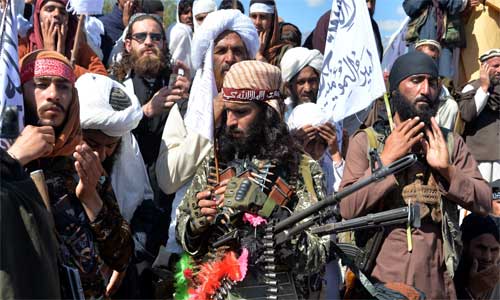It was believed from sometimes now that Tehrik-e-Taliban Pakistan (TTP) aka Pakistani Taliban has been marginalized and in disarray. As Pakistan’s army operations back in 2014 had ousted the Taliban insurgents from their most prized tribal sanctuary. The movement’s various factions were riven by violent rivalries, and attacks on Pakistan’s towns and cities had largely ceased because of this. But since March this year, TTP fighters have killed around 40 soldiers, according to a Reuters tally of official figures. Even the recent United Nations Security Council reports states that. The total number of Pakistani foreign fighters in Afghanistan, posing a threat to both countries, is estimated at between 6,000 and 6,500, most of them with TTP. The TTP used to be an umbrella for several jihadi and sectarian groups that emerged in Pakistan’s tribal region during and after the rule of the Taliban regime in Kabul. This loose but highly effective alliance was forged in late 2007 with Baitullah Mehsud, an Afghan war veteran from Waziristan’s Mehsud tribe, as its first Ameer or leader. Having once seized control of most of the Waziristan region, and carried out complex operations from Peshawar to Karachi and Lahore. The TTP was seen as an existential threat in Pakistan’s policy circles until 2014. But TTP was struck by Pakistan’s military massive military operation Zarb-e-Azb in June 2014. That not only shattered the TTP’s command and control structure in the tribal region but also forced the group to take refuge across the border in Afghanistan’s east.
In addition to this appointment of Maulana Fazlullah as the leader in 2014 made the TTP a divided house. Several factions parted ways with the group when Mullah Fazlullah, a non-tribal and non-Mehsud leader took charge. But Fazlullah’s death in a June 2018 drone strike, however, changed the internal dynamics altogether. It shifted the leadership back to the Mehsud Taliban which forms the core of the organization as the shura appointed Mufti Noor Wali as its new chief. Noor Wali’s appointment as the Ameer encouraged many of those who had been dissatisfied with Fazlullah’s leadership, in large part because he was not a Mehsud, to re-join the group. Since taking over command of the TTP, Mufti Noor Wali has worked extensively to revive the group by bringing in those who had parted ways with the TTP since 2014. The militants of the “Hakimullah Mehsud Group” headed by commander Mukhlis Yar were the first to come back to the TTP fold. The announcement was made in an Urdu language TTP press release on July 6, 2020. The same month it was announced that the so-called Punjabi Taliban’s al-Qaeda-affiliated Amjad Farouqi group has joined the ranks. Then the TTP media cell announced in August this year. That the Ameer Usman Saifullah Kurd group of Lashkar-e-Jhangvi, headed by Maulvi Khush Muhammad Sindhi, had joined the TTP by expressing allegiance to its chief Noor Wali Mehsud.
Most importantly the two major and violent Taliban factions Jamaat-ul-Ahrar (JuA) under Omar Khalid Khurasani and Hizb ul-Ahrar (HuA) led by Omar Khurasani re-joined the TTP conglomerate on August 17, 2020. Noor Wali is also working to persuade Mangal Bagh and his Lashkar-e-Islam to join the TTP. Bagh fled across the border into Afghanistan amid the launch of Operation Zarb-e-Azb in 2014. Bagh had never formally joined TTP but was a major ally. Also, Hafiz Gul Bahadar, whose group is hiding in the North Waziristan tribal district may join the TTP. He signed a peace deal with the Pakistani government in 2006 which was renewed in 2008. However, he renounced the deal in May 2014 by accusing the Pakistani government of launching airstrikes in North Waziristan. He is believed to be in close contact with the TTP chief. One thing is certain that the Pakistan Taliban reconciliation process has been a success till now. This for sure has led to increased strength and operations which is clearly evident from increased attacks by the organization. Also, TTP no longer wants to lie low and keep a low profile it’s getting bolder. It released a statement asking residents to vacate the former tribal regions of Khyber Pakhtunkhwa province, as the group plans to launch more attacks on security forces. Hence it will be right to say that Pakistan Taliban is rising from the ashes.
It’s a matter of fact that still, Tehreek-I-Taliban Pakistan (TTP) is the largest militant group in Pakistan. They may not be able to control large swaths of territory in tribal areas as it used to do till 2014. But can definitely launch a new wave of terrorist attacks across Pakistan if not checked in time. The real operational strengths of Pakistan Taliban are its affiliates and support networks, which still exist inside Pakistan. Taliban supporters and sympathizers provide the base and facilitate the movements of fighters without which no attack can be planned and executed. So Pakistani authorities have to identify and break up local terrorist networks that support TTP, counter radical ideology through a deradicalization program for youths, and more importantly, take adequate measures to address grievances in tribal areas.
Home » Opinion » Pakistani Taliban Pushing for Come Back
Pakistani Taliban Pushing for Come Back
| Manish Rai

